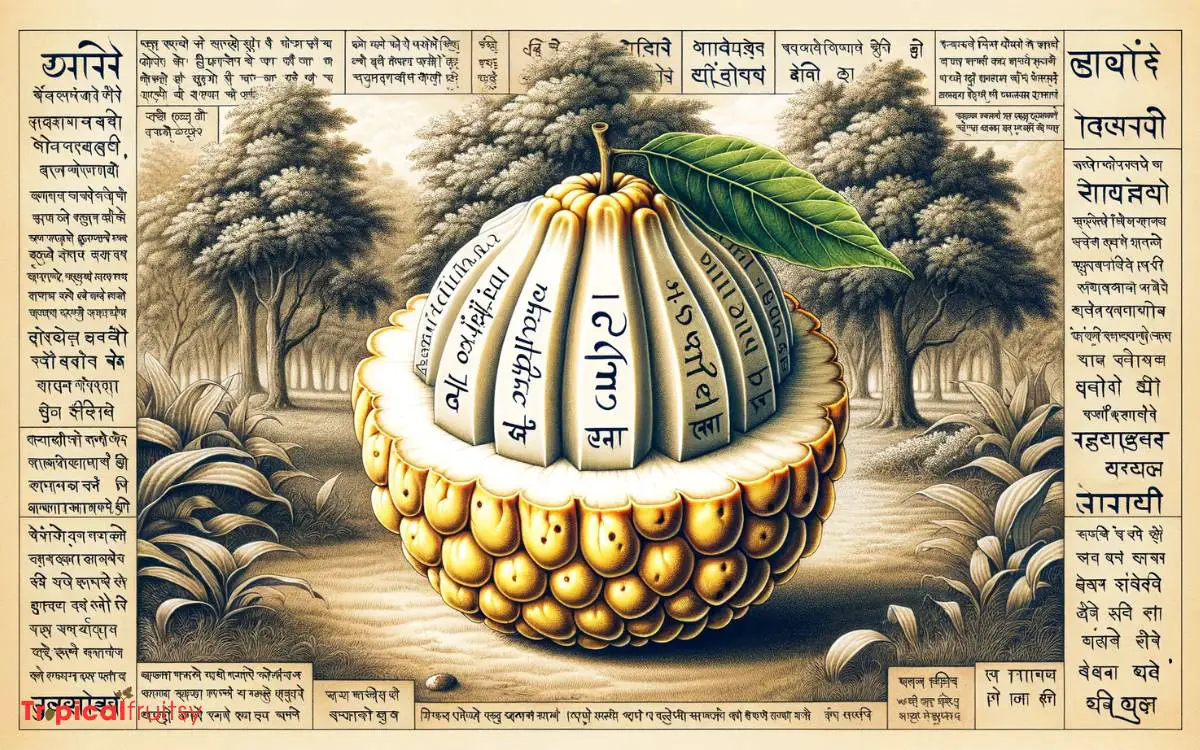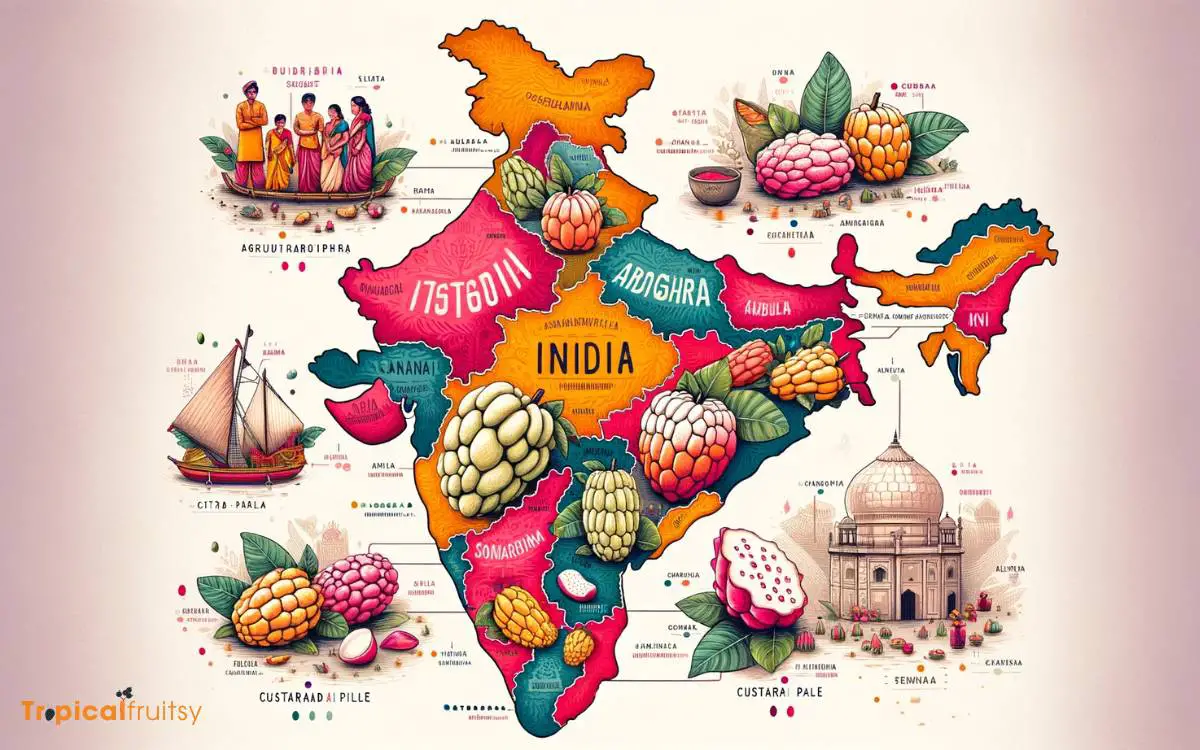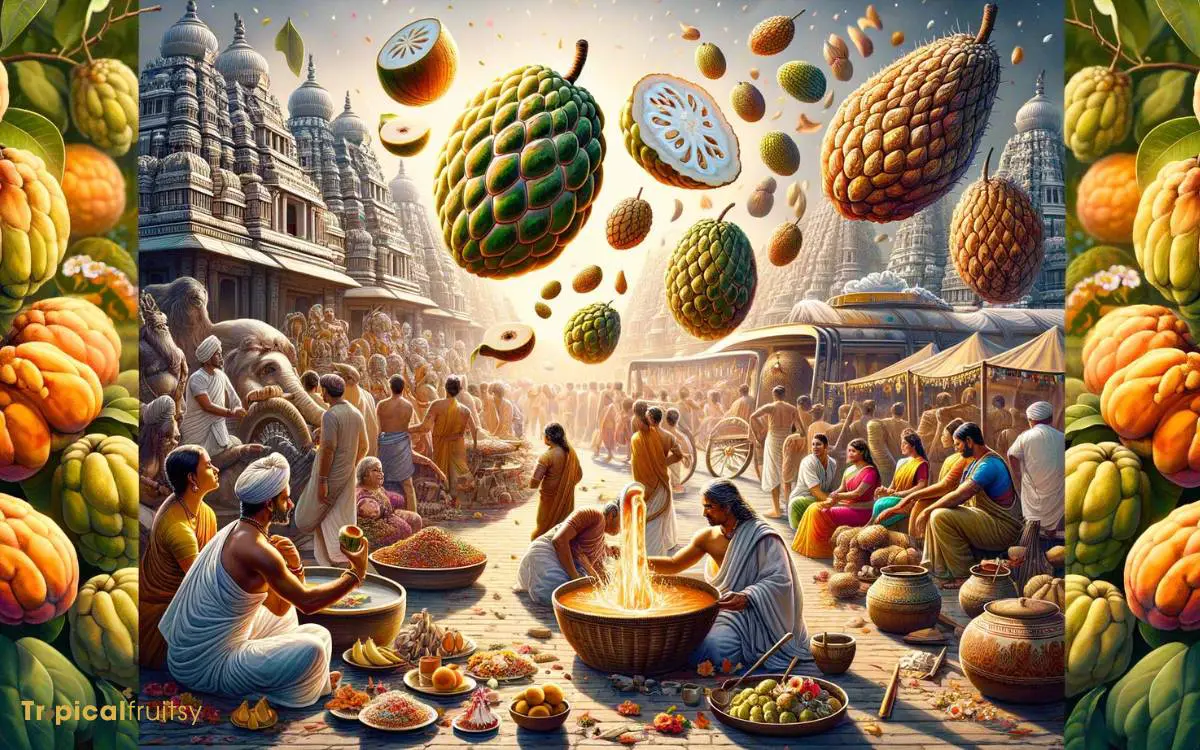Why Is Custard Apple Called Sitaphal? Explained!
Custard apple, also known as Sitaphal in India, is a sweet, creamy fruit with a bumpy green skin. It gets its name from the flesh’s custard-like texture and the sweet flavor that resembles traditional custard.
Custard apple, or Annona squamosa, is a tropical fruit native to the Americas and West Indies but is now widely cultivated in Asia, including India.
In India, it’s popularly known as Sitaphal, which in Hindi translates to “fruit of Sita,” a reference to the beloved goddess Sita from the Hindu epic Ramayana.
The name reflects the cultural significance and the divine sweetness of the fruit. The fruit’s texture, which is soft and creamy like custard, is the reason for its English name, ‘custard apple.’
Here are some key attributes of the fruit:
Custard apple, or Sitaphal, is a delight in both taste and nutrition, offering a heavenly flavor that’s as rich as its cultural significance in India.

Key Takeaway
Understanding Custard Apple

I’ve discovered that the custard apple, a fruit belonging to the genus Annona, is cherished for its sweet, creamy texture and distinctive flavor.
Its appeal lies not just in taste but also in its nutritional profile, which includes a significant amount of vitamin C, dietary fiber, and essential minerals such as magnesium and potassium.
This composition suggests potential health benefits, such as bolstering the immune system and aiding digestion.
Methodically examining its nomenclature, ‘custard’ likely references the fruit’s consistency, while ‘apple’ perhaps denotes its round shape.
However, the moniker ‘Sitaphal’ in certain regions, such as India, is steeped in cultural and mythological connotations, further enriching the fruit’s identity within different ethno-botanical contexts.
The Name ‘Sitaphal’ Explained

In my exploration of the fruit’s nomenclature, I’ve found that the term ‘Sitaphal’ is linked to the Sanskrit words ‘Sita’, a reference to the goddess from Indian mythology, and ‘phal’, meaning fruit.
This etymological association offers a significant insight into the cultural and religious backdrop that influences the naming conventions within the region.
‘Sita’, as a revered figure, implies purity and richness, qualities that could be symbolically attributed to the fruit itself.
Delving deeper, the appellation suggests a certain sanctity, possibly elevating the fruit’s status in local contexts.
The use of ‘phal’ straightforwardly classifies it within the category of fruits, reinforcing its identity in the vernacular lexicon.
This scholarly angle leads me to ponder the mythological connections that may have further shaped Sitaphal’s name.
Mythological Connections

In examining the mythological connections of the custard apple, it’s crucial to acknowledge its association with Sita, a central character in the epic Ramayana.
This fruit is traditionally considered Sita’s favorite, which provides a cultural context to its naming as ‘Sitaphal’.
Furthermore, I’ll scrutinize the interpretations of its divine symbolism, which have contributed to its revered status in certain religious narratives.
Sita’s Favorite Fruit
Amidst the rich tapestry of Hindu mythology, it’s believed that the custard apple, or sitaphal, was a cherished fruit of Sita, the goddess it’s named after. This connection isn’t merely incidental but is steeped in symbolic connotations.
Analyzing the texts, one finds that Sita, an embodiment of fertility and abundance, is often associated with bountiful harvests and nurturing elements.
The custard apple’s lush, seed-filled interior can be seen as a representation of these qualities. Furthermore, the fruit’s sweetness parallels the narratives of Sita’s gentle and nurturing nature.
While explicit textual evidence linking Sita directly to the custard apple is scant, the etymological assignment of ‘sitaphal’ underscores a deeper, culturally ingrained association.
Thus, it seems that the naming is both a nod to Sita’s virtues and an allegorical reference to fertility and sustenance.
Epic Ramayana Reference
I’ll now delve into the Ramayana, where the mythological connections between the custard apple and the epic’s narrative become evident.
The Ramayana, a venerable Indian epic, is replete with allegorical tales that have permeated cultural traditions.
In the context of the custard apple, the fruit’s nomenclature in India as ‘Sitaphal’ is intrinsically linked to Sita, the epic’s revered heroine.
Methodically examining the text reveals that while the fruit itself isn’t explicitly mentioned in the Ramayana, its association with Sita is likely a post-textual intertwining of cultural beliefs and narrative traditions.
This appellation reflects the fruit’s perceived sweetness and fertility, traits often ascribed to the virtuous Sita. Hence, the custard apple’s name serves as a symbolic homage to her character within the epic.
Divine Symbolism Interpretation
Why then does the custard apple bear a divine symbolism, echoing mythological connections beyond its mere naming?
The fruit’s association with the goddess Sita in the epic Ramayana isn’t merely coincidental. It’s laced with layers of symbolism that require a methodical analysis to unravel.
The custard apple, or sitaphal, is often seen as a representation of fertility and divine blessing, perhaps mirroring Sita’s own revered status as an embodiment of earth’s bounty and purity.
| Aspect | Symbolism | Connection to Sita |
|---|---|---|
| Form | Fertility | Earthly embodiment |
| Taste | Divine blessing | Nectar of the Gods |
| Seeds | Multiplicity | Abundance of life |
Historical Naming Practices

As we turn to historical naming practices, I’ll scrutinize the etymological roots of ‘Sitaphal’, tracing back through ancient texts to uncover how cultural influences have shaped its nomenclature.
It’s essential to dissect the layers of linguistic evolution that inform the present-day use of the term.
I’ll reference specific ancient manuscripts to validate the historical continuity and transformation of the name ‘Custard Apple’ in different societies.
Etymological Roots
The name ‘Sitaphal’ for custard apple has its origins in the Sanskrit words ‘sita,’ meaning white, and ‘phal,’ which translates to fruit.
This nomenclature is deeply rooted in historical linguistics, reflecting the descriptive nature of ancient naming practices.
The creamy, whitish pulp of the fruit likely inspired its Sanskrit moniker.
To dissect this further:
- Sita: Denotes the color or characteristic of the flesh of the fruit.
- Phal: A general term used for fruit, signifying the category of the produce.
- Sanskrit: An ancient language that has profoundly influenced the lexicon of many South Asian languages.
Cultural Influences
I’ll now explore how historical naming practices, steeped in cultural traditions, have contributed to the custard apple being known as ‘Sitaphal’.
The term ‘Sitaphal’ is deeply rooted in the Indian subcontinent’s nomenclature, reflecting both linguistic and mythological legacies.
The Sanskrit name ‘Sitaphal’, literally translating to ‘fruit of Sita’, illustrates the cultural significance associated with this fruit.
To elucidate, I present the following table that dissects the cultural layers behind the naming:
| Aspect | Description | Relevance |
|---|---|---|
| Etymology | Derived from Sanskrit | Highlights linguistic heritage |
| Mythology | Associated with Sita, a goddess | Indicates mythological significance |
| Geography | Popular in South Asia | Reflects regional prevalence |
| Usage | Common in traditional cuisine | Embodies cultural continuity |
| Linguistic Adoption | Incorporated into various languages | Demonstrates linguistic assimilation |
This methodical breakdown illustrates how the custard apple’s name is a tapestry of historical and cultural influences.
Ancient Texts References
Delving into ancient scripts, I’ve discovered references that underscore the historical importance of custard apple, known as ‘Sitaphal’ in these texts.
These documents aren’t merely casual mentions but rather indicate a deep cultural and medicinal value attributed to the fruit. The meticulous nature of these ancient catalogues showcases the reverence held for Sitaphal.
To illustrate:
- Sanskrit texts, such as the Amarakosha, classify the fruit under the name ‘Sitaphal’ and detail its properties.
- Ayurvedic treatises enlist ‘Sitaphal’ for its cooling effects and digestive benefits, highlighting its therapeutic uses.
- Historical agricultural compendiums discuss the cultivation methods and regional adaptations of ‘Sitaphal’, pointing to its horticultural significance.
These bullet points are a testament to the profound legacy of custard apple within historical narratives.
Etymology of ’Sitaphal

My investigation into the etymology of ‘Sitaphal’ reveals that the term originates from the Sanskrit words ‘Sita’, referring to the wife of Lord Rama in Hindu mythology, and ‘phal’, meaning fruit.
This nomenclature isn’t merely a linguistic conjunction but also carries cultural significance.
In the Indian subcontinent, where the custard apple is widely cultivated and consumed, associating the fruit with a revered mythological figure like Sita adds an element of sanctity and endearment.
It’s plausible that the fruit’s sweetness and richness contributed to its naming, symbolically linking it to the virtues and grace associated with Sita. Hence, ‘Sitaphal’ isn’t just a name but a term steeped in religious lore and societal esteem.
Regional Variations in India

In exploring the regional variations of the custard apple’s nomenclature in India, I’ve come across a rich tapestry of local names that reflect the diverse linguistic cultures of the region.
These appellations aren’t just mere translations; they’re imbued with cultural significance and local lore that provide a deeper understanding of the fruit’s place within each society.
- Sharifa in Hindi, prevalent in North India, hints at a noble lineage, perhaps likening the fruit’s value to that of a noble personage.
- Seetha Pazham in Tamil and Seethaphal in Telugu, used in the South, are directly associated with the mythological tale of Sita, indicating a sacred connection.
- Ata in Bengali, a linguistic deviation that suggests a unique cultural assimilation of the fruit into the Bengali tradition.
Each term offers a window into how regional identities shape the perception and ultimately the nomenclature of this beloved fruit.
Cultural Significance

Exploring these regional names has led me to uncover the cultural significance of custard apple, particularly how it’s revered in various traditions and myths.
Often, the fruit’s nomenclature is imbued with historical and mythological narratives that transcend mere sustenance.
For instance, in Indian culture, the custard apple is associated with the goddess Sita, a central figure in the epic Ramayana, which explains the vernacular moniker ‘Sitaphal’.
This association imbues the fruit with a divine essence and positions it within a framework of sacredness.
Moreover, the fruit’s incorporation into religious ceremonies and festive rituals underscores its cultural resonance. It’s not just a dietary staple but a symbol of prosperity and fertility.
Methodically analyzing these cultural contexts reveals the layers of meaning that a simple fruit can hold within a society.
Sitaphal in Indian Cuisine

I’ve discovered that Sitaphal, the custard apple, is a versatile ingredient in Indian cuisine, finding its place in a variety of sweet and savory dishes.
Its unique texture and flavor profile enrich Indian gastronomy, offering both nutritional value and culinary diversity.
Analyzing its usage, I note the following applications:
- Sitaphal Rabdi: A creamy dessert where the fruit’s pulp is mixed with thickened milk and cardamom, offering a lush sweetness.
- Sitaphal Curry: Here, the fruit adds a natural creaminess to gravies, paired often with spices that complement its subtle undertones.
- Sitaphal Ice Cream: This delicacy incorporates the pureed fruit into ice cream, creating a rich and exotic flavor that’s both refreshing and indulgent.
Each dish showcases Sitaphal’s adaptability and its esteemed place in the culinary tapestry of India.
Global Names for Custard Apple

My exploration into custard apple’s various monikers reveals a tapestry of names across different cultures, reflecting its widespread appreciation.
In Latin America, it’s known as ‘chirimoya,’ derived from the Quechua word ‘chirimuya,’ which means ‘cold seeds.’
The Spanish influence perpetuated this term, emphasizing the fruit’s prevalence in cooler, highland regions.
The Caribbean and some parts of Southeast Asia refer to it as ‘sweetsop,’ a name that underlines its sugary flavor profile.
In North America, the term ‘custard apple’ is commonly used, likely due to its creamy texture reminiscent of custard desserts.
Each regional nomenclature not only identifies the fruit but also encapsulates a unique aspect of its sensory experience or cultural significance, underpinning the analytical need to understand the etymological roots behind the name.
Conclusion
In essence, ‘Sitaphal’ is more than a name; it’s a cultural tapestry interwoven with myth, tradition, and linguistic threads spanning the diverse Indian subcontinent.
As I’ve dissected its etymology and regional nuances, it’s clear that this fruit’s title is deeply rooted in the soil of history, blossoming into a term that carries the fragrance of ancient tales and the flavor of cultural identity, enriching the banquet of our collective heritage with every succulent bite.






